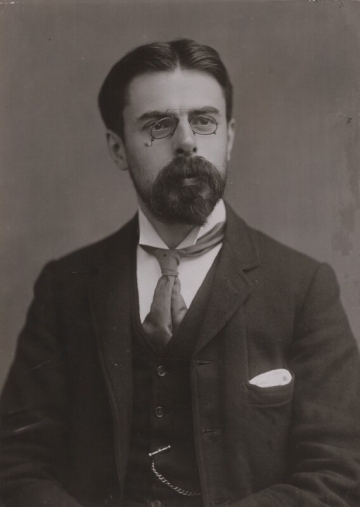Laurence Housman
The full resource is FREE to all registered users of the website
If you are not already registered you can sign up for FREE website access to download the full resource.

- Born: 1865
- Died: 1959
- Occupation: artist and writer
- Claims to fame: originated the idea of the 1911 census boycott
Early life
Laurence Housman was born in Bromsgrove, in a middle-class family. He was close to his sister, Clemence. In 1909, Laurence and Clemence helped to found the Suffrage Atelier (SA). The SA designed and made suffrage posters, banners, postcards and other things, like book covers and curtains, which it sold to other votes for women supporters. Laurence designed some of these, such as the ‘From Prison to Citizenship’ banner that was used on several suffrage processions. Clemence did much of the SA’s needlework.
As a campaigner
In 1914, Laurence was one of the founding members of the United Suffragists (US) and was arrested that year for taking part in a protest with other men who supported women’s fight for the vote. He was quickly released, which he put down to his being a man and not a woman. Laurence supported the British Society for the Study of Sex Psychology, which worked to change attitudes and laws on sexuality. Laurence was a gay man at a time when you could be arrested for being homosexual. He became a pacifist during the First World War and, later, a campaigner against nuclear disarmament. Laurence supported the Men’s Political Union for Women’s Enfranchisement (MPU) and was a central figure in the Men’s League for Women’s Suffrage (MLWS). He toured the country, speaking, and wrote several popular plays and short stories tackling the arguments for and against votes for women, often in a witty way. Laurence also came up with the idea that suffragettes should boycott the government’s 1911 census survey – if they had no vote, why should they fill in the form? The census protest was encouraged nationwide by the Women’s Freedom League (WFL) and, later, by the WSPU, and women were helped to ‘evade’ the census by sleeping in organised groups away from their homes on census night (2 April 1911), when census officials called.
Did you know?
- Laurence contributed to the 1911 boycott by allowing ‘evading’ suffragettes to sleep over at his house, which officials noted on his census form.
- It was illegal to be gay in the UK until 1967, forcing many men to hide their identity.
Questions
- Why do you think he supported the suffrage cause?
- Do you think men joining the campaign made a difference to men and/or women?
- Do you think that many men supported suffrage?
Useful resources
- Elizabeth Crawford, The Women’s Suffrage Movement: a reference guide, 1866–1928 (Routledge, 1999)
- Elizabeth Oakley, Inseparable Siblings: a portrait of Laurence and Clemence Housman (Brewin Books, 2009)
